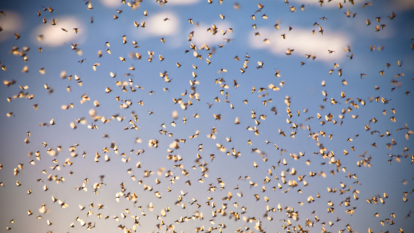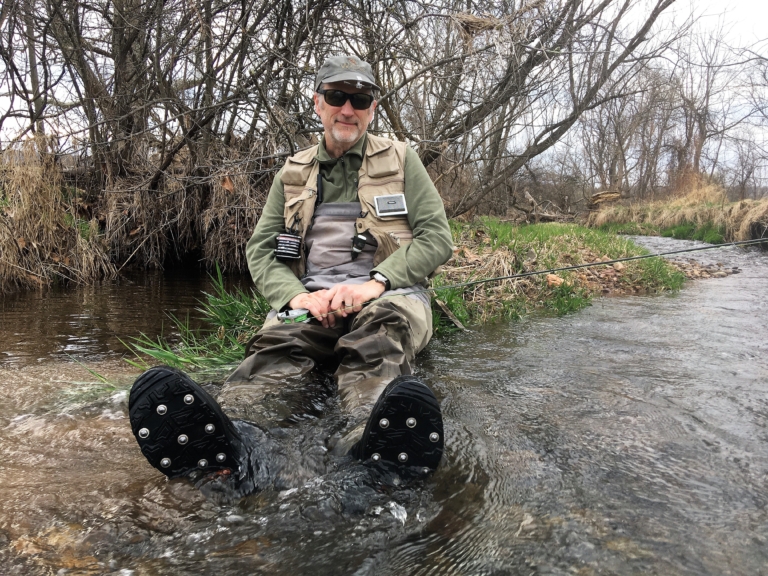Dude, Where’s My Hatch?
The decline of aquatic insects should bug everyone.
Trout anglers speak reverently of the “evening rise,” an almost mystical phenomenon when a cold-water river shares its living bounty of aquatic insects with the rest of the natural world. Witnessing one unfold like acts in a play, complete with drama, beauty, sex and death, is one of fly fishing’s greatest spectacles.
It begins when the sun lowers and the sky turns golden. Crepuscular rays catch the transparent wings of mayfly spinners—sulfurs, drakes, March browns—as they dance in courtship overhead. A few golden stoneflies lumber around, splaying their wings before belly flopping onto the stream to force egg sacks below the surface. Squalls of caddis whirl just above the water.
Swallows weave and barrel roll, mouths hang agape like humpback whales on krill. Warblers, waxwings and catbirds pick out individual targets. They fly from their perches to intercept the slow and the unlucky. Dragonflies, too, patrol. They move laterally into the scrum, grab a mayfly and leave behind a pair of wings that helicopter downward minus a body.
Cue the trout. The first rises are tentative, but slowly build in number and enthusiasm as spent insects hit the water to lay their eggs and die. Casts are made. Flies sucked down. Fish leap. Reels sing. The light dims. Bigger fish enter the stage. Reels soar into arias. Splashes sound more like livestock than trout. Headlamps click on and off as trout are released. Then full darkness sets in and, finally, it ends. Roll credits.
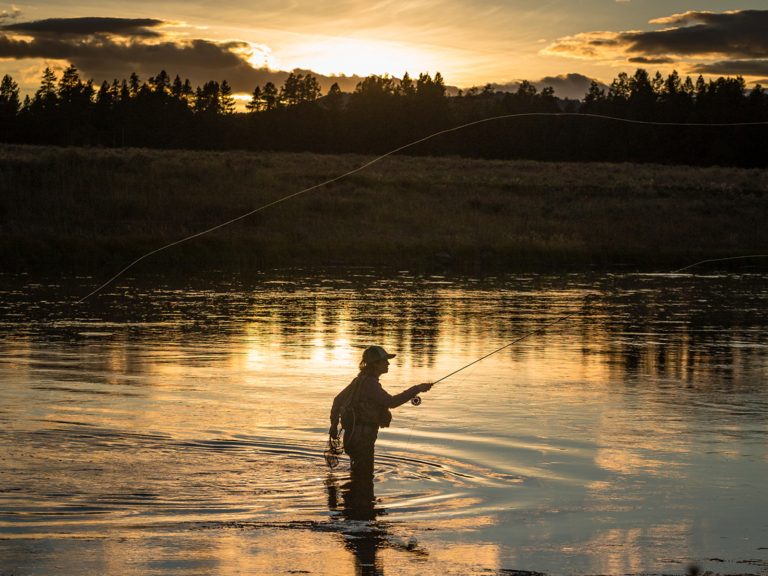
Millie Paini squeezes a few more casts from the day on Idaho’s Henry’s Fork. Long after most anglers have left the water, rivers often see robust emergences of aquatic insects—and recklessly feeding trout. Photo: Bryan Gregson
Last June, I sat on a favorite rock on my home water, the East Branch of the Delaware River, awaiting this performance. The setting was perfect; the light softened, the river cool and flowing. Warblers and thrushes sang in anticipation behind me. Except there was one thing missing: bugs. Sure, I saw a few scattered mayflies and some black caddis ghosting just above the surface. But what should have been a cumulonimbus of insect activity was barely a wisp. Yes, a trout rose here and there, and I even managed a regulation East Branch 16-inch wild brown on a sparkle dun. But something was definitely off.
And this was not the first time. Far from it. For the past several seasons, on a stretch of river that I have fished for nearly 20 years, I have noticed a steady decline of hatching aquatic insects. There are days when bugs still come off and trout rise. And when that happens, all seems right in the world. But more times than not, the consistency and duration of hatches are way down. The three-week Hendrickson emergence has dwindled to a spotty week and a half. March browns, never overly abundant but predictable and steady, now come off one here, one there. Blizzards of caddis have downgraded to a dusting. Nowadays, I often sit and wait, shoulders slumped, until I eventually sulk back to my car in the darkness, a jilted lover.
There are other streams, too, I have noticed. The sulfur hatch on Pennsylvania’s Brodhead Creek was once so thick it was nearly impossible to compete with the living, moving mat coming down the river. It is now sporadic at best, with entire stretches seemingly devoid of once ubiquitous mayflies.
But maybe it was me, not the bugs. Perhaps I hit several years of bad luck and bad timing on my local streams. The tired fishing cliché is, “You should have been here yesterday.” Maybe I should have been here yesterday since 2015. So I posed the question on social media, asking whether other anglers had witnessed a dearth of insect activity. The replies I received were telling.
“Mayfly hatches seem to be way down. When I fished in the ’80s with my dad in the Upper Delaware watershed, hatches were like snow … Anecdotal, but I don’t see that anymore.”
“The anxiously awaited Hendrickson hatch on the Housatonic seems to have faded to near nothing.”
Then others seemed to contradict what I was observing, but with caveats: “Solid hatches on Penns Creek all season, but old-timers tell me they’re not like before …”
And finally, a reply from an EPA scientist’s personal account summed it up best: “Seems a continent-wide observation, undoubtedly borne out in many waters but coupled with blurry exceptions in others. We don’t monitor with precision for these ecologically and culturally important flies to answer basic questions, unfortunately.”
The science on the global decline of insects confirms this blurriness. In 2017, a team of German scientists published a jaw-dropping study documenting a 75 percent population crash of insects in local nature reserves. This prompted The New York Times to declare: “The Insect Apocalypse Is Here.” The story goes on to note a shortage of past evidence that would serve as a baseline to compare the 27-year-decline found in Germany. But it describes efforts being made to piece together long-forgotten data that might offer clues, and it shows that scientists elsewhere also have noticed far fewer insects. Almost three years later, a study in the journal Science revealed a 9 percent drop in terrestrial insects per decade—but an 11 percent increase in aquatic insects. Yet this was a “meta-analysis” that reviewed existing studies from around the world rather than conducting its own original field research. The authors said that the growth in aquatic bugs could have been from general trends of cleaner lakes and rivers—or increased nutrient loads related to climate change. Other studies were more definitive, though equally broad in scope. A 2019 paper said that 40 percent of the world’s insects could vanish over the next few decades, but it looked at mostly butterflies, moths, bees, dragonflies and beetles to draw its dire conclusion. Some scientists challenged the results, citing an overall lack of evidence. Then two years ago, a more specific study in the Proceedings of the National Academy of Sciences (PNAS) used radar observations to determine that annual Hexagenia mayfly swarms in the upper Mississippi and Western Lake Erie basins had plummeted by half.
Think of your own backyard growing up, or maybe a place where you camped each summer. Imagine the porch light at your grandmother’s house. Remember moths, lightning bugs or katydids? Do you see fewer than you once did? One criterion cited in the Times story was the “splatter effect” on windshields from collisions with bugs and how this seems to be lessening. Speaking for myself, and using the porch-light metric, what once was a maelstrom of bugs swirling around the light at my cabin in the woods of upstate New York has become an anemic whimper in recent years. Large moths—luna, cecropia and polyphemus—once a delightful, several-times-a-summer spectacle, now show up maybe once every other year. Is this peer reviewed science? No, but it certainly jibes with what entomologists are observing.
No other outdoor pursuit, except maybe amateur beekeeping or butterfly collecting, directly depends upon, reveres and celebrates insects like fly fishing. Anglers joyfully geek out on Latin bug names, even creating their own slang: Isonychia bicolor, or slate drakes, are “Isos”; the genus Tricorythodes become “Tricos,” or if you’re really cool, “Trikes.” The aforementioned Hexagenia is shortened to the badass-sounding “Hex.” I once saw a vanity license plate that read “BAETIS”—the genus for the blue-winged olive mayfly. We tie painstaking imitations of specific life stages of particular aquatic bugs: egg-laying caddis, March brown and sulfur dun emergers. We time vacations around certain hatches on certain rivers. Good luck booking a motel room in the Catskills during “Bug Week” around the end of May when the green drakes are out or having a pool to yourself on the Madison during the salmonfly hatch. Without healthy, vibrant aquatic insect populations, fly fishers—particularly trout anglers—might as well take up golf.
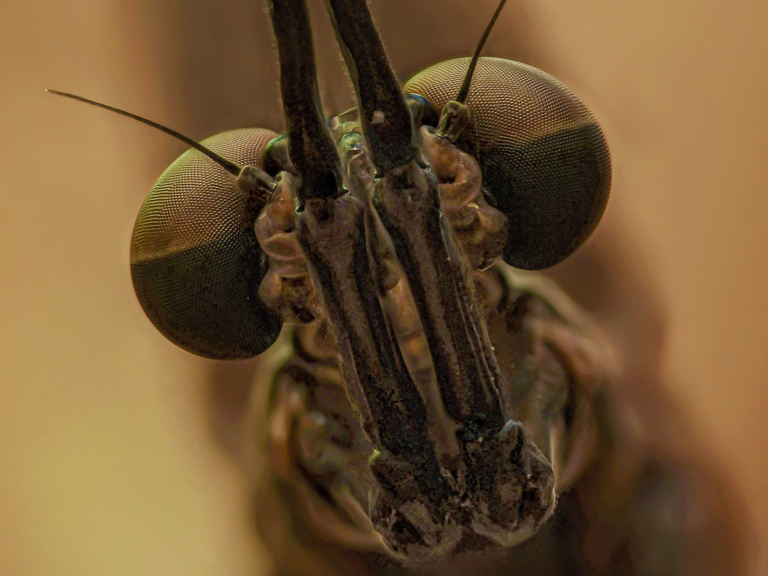
Eye to eye with a mayfly. Winged mayflies have large compound eyes and short antennae. Once they emerge from their nymphal stage, mayflies cannot feed. Instead, they’re often a favorite snack of hungry trout. Photo: Trey Wardlaw
Let’s put fly fishing aside. If you start to pull on the thread of what else relies on aquatic insects, things get downright scary. Look around most North American trout rivers during the spring, and the foliage drips with migratory birds hunting and pecking molting mayflies, resting caddis or stone flies—not to mention caterpillars, inchworms, aphids and more. Some migrants have traveled from as far away as the Andes to take advantage of this seasonal bounty. Remove the birds and you have lost a key cog—a natural pest manager and seed disperser. So expect a compromised forest, one subject to disease and invasive species, and less able to sequester carbon and protect watersheds. Include bees in the decline and you also lose other ecosystem services like pollination. In other words, a crappy Hendrickson hatch could be the foretelling of something much worse.
So what can we do about it? The truth is, no one really knows precisely what is causing the decline. Still, the widespread use of pesticides is often implicated, along with other factors. The PNAS study’s authors link the Hexagenia disappearance to lower dissolved oxygen levels from warming water due to climate change, plus fertilizer runoff from farms that spawn toxic algae blooms.
You can and should blame big agriculture for pesticides and fertilizers, but also consider your own backyard. In my suburban neighborhood in New Jersey, lawn services lord over the land. Every spring, they dump fertilizers and broadcast spray to control “pests,” whether weeds or insects (many of which are beneficial). Throw in carbon-spewing two-cycle leaf blowers and military-grade mowers and you have a full-on assault on the habitat. Ironically, many homeowners who hire lawn-servicing companies also drive EVs and have installed solar panels, so there is clearly a disconnect here. By the way, the porch light metric at my suburban house is truly dismal, with just a moth or two and a few errant midges circling even on the muggiest—and presumably buggiest—nights. Not all of us have lawns, but those who do should ditch the lawn service and grab a rake or battery-powered push mower. Or seed (and cede) that lawn with native plants and become more weed tolerant. Dandelion flowers are an early-season food and pollen source for bees and butterflies.
For urban dwellers, buying organic or pesticide-free food would be one way to vote pro-bug with your wallet. And, of course, any chance to reduce one’s carbon footprint, including voting for a green agenda, would make a mayfly smile if they had a mouth (adult mayflies do not).
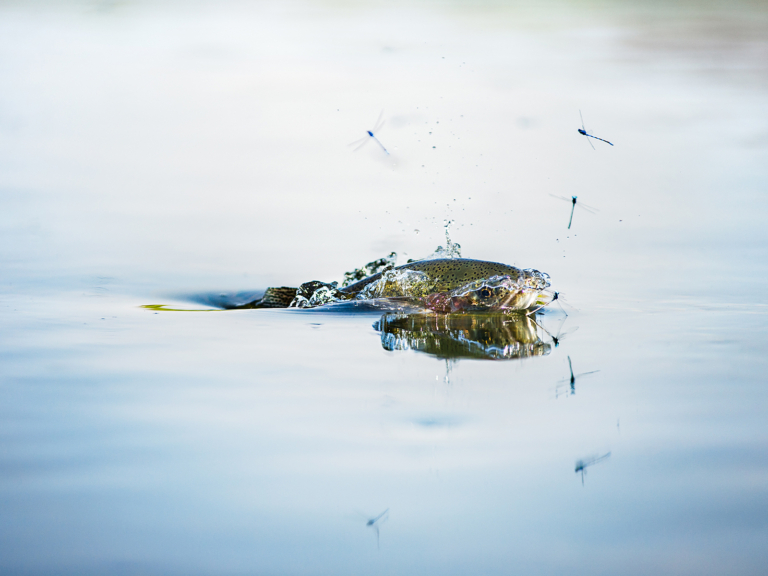
Dinner is served. A mouthful of unlucky damsel flies fail to escape a voracious rainbow trout on Idaho’s Silver Creek. Photo: Nick Price
Speaking of lights, a 2020 study in the journal Biological Conservation noted how artificial lights—everything from streetlights to the flaring of gas wells at night—could be laying waste to untold numbers of insects. It’s possible that the array of high-powered fluorescent lighting we see around every gas station and strip mall and increasing illumination outside suburban homes are taking their toll. The ones near trout streams suck insects away from more important duties: mating and laying eggs (a Smithsonian article about the Biological Conservation study mentioned light reflection on roads tricking mayflies into laying eggs on asphalt instead of water). The next morning, dead bugs pile around the light fixtures, the end result of exhausted energy reserves squandered by endlessly circling a 7-Eleven sign. You may not own a convenience store, but how about flipping those light switches off at home before you go to bed?
Is all of this just alarmism from a few fly fishers crying in their floatant, pining for the good old days? Consider the Neversink. The storied trout river rises in the shadow of Slide Mountain, the Catskills’ tallest peak, then wends its way to the Delaware some 60 miles away. Dry-fly pioneers Theodore Gordon and Edward Hewitt made their first casts here more than a century ago. It purportedly once supported a green drake hatch, the floppy, jumbo-sized mayfly that famously brings up every trout in the river. But dams, deforestation and development have apparently taken their toll. Fish the Neversink in late May or early June and you might see a handful of green drake spinners, sometimes called coffin flies, making their way upriver at dusk, their long white abdomens seeming to glow in the twilight. But it no longer seems to be a true “hatch” with birds, bats, trout, fallfish, spiders and dragonflies gorging on a healthy river’s bounty. The remaining drakes are mere ghosts of what was. Dead bugs flying.
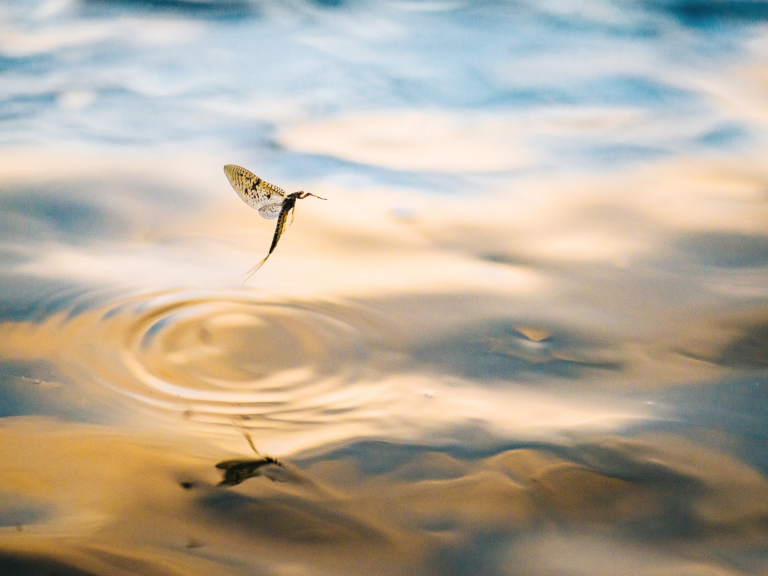
Dinner is not served. A lucky brown drake mayfly reaches escape velocity on Idaho’s Henry’s Fork of the Snake. Photo: Jeremiah Watt
Conservation biologists refer to the “Allee effect” where the health of individuals is directly dependent on the size of the population. Passenger pigeons needed massive numbers—literally billions of individual birds—to survive as a species. When overhunting and clearing of old-growth forests drove numbers below a certain threshold, they went into a decades-long death spiral. The last passenger pigeon, once the most abundant bird in North America and perhaps on the planet, died in a zoo in 1914. Whether some insect hatches, whose strategy also seems to be strength in overwhelming numbers, have already reached that tipping point remains to be seen.
Can humanity turn the insect decline around? Fly anglers are optimistic by nature. Each cast we make is a physical manifestation of hope. We believe that every new fly we tie will be “The One” to surely crack the code. That optimism needs to translate into advocacy or at least personal action to reduce one’s own bug-stomping footprint. The same way steelheaders need to be anti-dam, trout anglers should be pro-bug. Let’s make “save the tricos” a trend. As for myself, come next spring, I plan to be back on my rock on the East Branch, ever hopeful the bugs will return. As I said, when the hatches come off, warblers sing, dragonflies buzz and trout rise, the world is a beautiful place—one worth fighting to protect.
